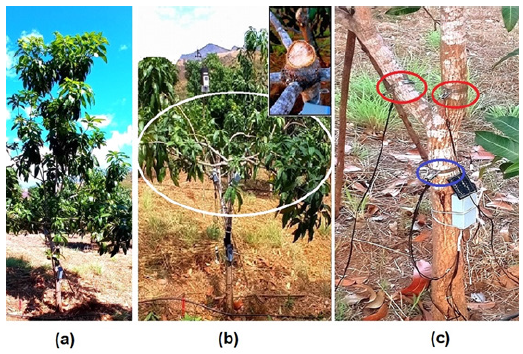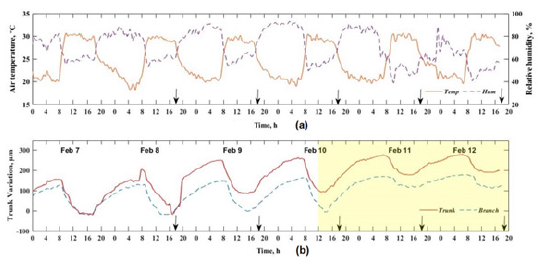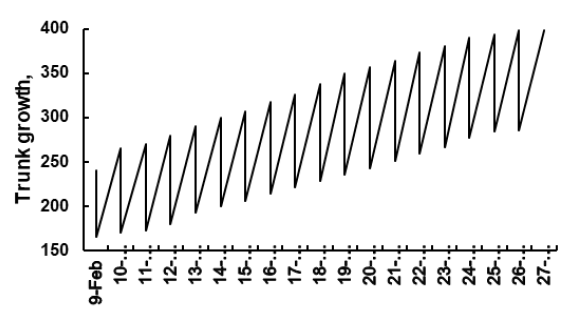- Submissions

Full Text
Modern Concepts & Developments in Agronomy
Analysis with a Dendrometer of Pruned Mango Trees
Federico Hahn* and MI Jesús García Martínez
Department Irrigation, Universidad Autonoma Chapingo, Texcoco, México
*Corresponding author: Federico Hahn, Department Irrigation, Universidad Autonoma Chapingo, Texcoco, México
Submission: March 24, 2022 Published: April 21, 2022

ISSN 2637-7659Volume10 Issue 5
Abstract
Mango is the main fruit produced in Mexico and it is exported to Canada, US and Europe. Older Tommy Atkins farms are being replaced by high density Keitt plantations, that are easier to manage and increase fruit yield. Tree pruning is a fundamental labor, so that a better floral distribution takes place. Several dendrometers were placed in juvenile 10-year-old trees, monitoring daily trunk and branch fluctuations. Dendrometer trunk measurements showed stable values previous to pruning of two main branches. Results show how the tree trunk grows one day after pruning, as well as the remaining branches.
Keywords: Dendrometer; Keitt; Pruning; Leaf removal
Introduction
Mango is the main fruit grown in Mexico and it is exported worldwide. Mexico grows Kent, Keitt, Haden and Ataulfo mango fruits with a production of 8.98MT ha-1 [1]. In Mexico as in other countries the mango supply chain, consists of producers, brokers, wholesales, and retailers [2]; producers only earn a 10% of the final product cost. In order to avoid this supply chain, producers at the municipality of Tecpan de Galeana learnt how to produce fruit earlier in February. In February 2020, a 30kg-mango box for the national market is bought in 45US, meanwhile three months later its cost decreases to 7.5US. USA mango imports peaks from March to September, coinciding with the Mexican supply. USA buys mango fruit from Brazil and Ecuador during the other months [3]. In order to improve the performance of the mango value chain, it is necessary to understand what consumers want [4]. In many producing countries, quarantine-related delays at ports and borders due to COVID-19 constraints have slowed trade [5]. Farms and plantations profitability has been severely affected, after industry problems resulting in cancelled orders, particularly for small- to medium-sized producers [5].
Mango trees increase yield as canopy size becomes leafier. Twenty years after planting shading forces growth upwards. As canopy size increases, production moves upwards as flowers and fruits appear on stem terminals [6]. Mango trees are irregular in their cropping habit, having periods of irregular bearing and periods of alternate bearing in the same orchard [7]. Alternate bearing occurs in some cultivars and degrades as the plantation gets old [8]. Mango tree is suitable for floral manipulation and helps producers to obtain inflorescences out-of-season. Floral induction provide fruit for markets at times of maximum value [9].
High density mango plantations are becoming popular worldwide as they are easier to manage and does not decrease fruit yield. Commercial Tommy Atkins orchards in South Africa yielded 35.1t ha-1 having a high density of 550 trees per ha [10]. In orchards, mango trees are pruned removing 10-15cm of the top from old branches. This operation improves light penetration and leaf physiology [11]. Reduced flowering and productivity can result of tough pruning in old trees. Overall yield in mango tends to be higher with moderate pruning, but heavy pruning of old trees inhibits mango production for several seasons [12]. Although the huge research carried out with pruning, it is difficult to foresee how these results might be applied to highdensity plantations [8].
Point and band dendrometers are used to measure continuously the thickness of the trunk and branches. Daily oscillations of the trunk diameter due to sap flow are in the order of micron. Dendrometers monitor the tree transpiration cycle and its water storage capacity [13]. Mango stem response during flowering and fruit-growth was analyzed under different irrigation regimes [1]. Diurnal stem contractions result from water taken up at night that is lost from elastic stem tissues during daily transpiration [14].
Pruning the tips of mango stems stimulate branching flushes to form a dense canopy that will flower with intensity. It also removes previous year inhibiting panicle structures and restore quickly the productivity of shaped-pruned trees [6]. The effect of pruning within the tree should be understood and tree measurements can be used to simulate and predict its growth and yield. In this study, dendrometer monitoring provides information on mango tree trunk and branches growth before and after pruning the tree.
Material and Methods
Three juvenile “Keitt” trees were pruned at a commercial orchard in Loma Bonita (17° 25ʹ 47” N, -101° 11ʹ 19” W, 17m ASL), Guerrero, Mexico. The ten-year-old tress presented a height ranging between 3.4 and 4.2m (Table 1). The greater canopy diameter was found in the second tree with a diameter of 360cm, although it was not the highest. The diameter of tree number one at a height of 100cm was 13.4cm, just below trunk bifurcation (Figure 1c).
Table 1: Physical parameters of trees including height, trunk diameter, number of leaves, canopy diameter, and number of branches.

Figure 1:Keitt tree
(a) before pruning,
(b) after pruning, and
(c) showing attached dendrometers.

Trees were pruned with a manual saw removing from one to three branches. After removing one branch, 46% (white circle Figure 1b), 76% and 92% of the leaves remained within trees 1, 2 and 3 respectively. Figure 1a shows tree number one before pruning, and Figure 1b illustrates the tree after branch removal; the top view exposes the final pruned tree.
Each tree was irrigated with a 120lh-1 micro-sprinkler for a period of half an hour. The first tree was irrigated two days before pruning on February 8 and 9 of 2022, at 18hr., for a period of 30 minutes before sunset to avoid water evaporation. It was pruned with a manual saw on February 10th at 16:00h and irrigated two hours later.
In order to monitor trunk variations previous and after pruning, point dendrometers were fixed to the trunk (blue circle, Figure 1c) and branches (red circles, Figure 1c). The linear potentiometers were fixed to the tree using pressing clamps. In this way environmental airflow changes do not produce movements of the sensible sensor plunger. Measurements were taken every 30 seconds, averaged during 10-min periods and plotted during the sampling period.
Result and Discussion
The results of daily stem and branch fluctuations are shown in Figure 2b, including arrows that indicate irrigation scheduling. Figure 2b is pink highlighted just after tree pruning. Everyday red line peak rises with a constant slope. However, the minimum value monitored after noon showed a notorious change. On February 10th stem size at noon was 36% of the value monitored at sunrise. The next day after pruning (February 11th) stem contraction at noon was of 67%, mainly due to the lack of transpiration as 46% of the foliage was removed. The monitored branch presented a constant contraction of 92% before pruning, that decreased to only 38% after foliage loss. Branch measurements obtained before pruning showed that most of the water stored at the branch during the night is transpired letting almost zero liquid at midday. Sap/ water remained within the standing branch when the main branch was cut, and its value never reached zero after removing the leaves attached to it. Air relative humidity monitored nearby the branch (blue line Figure 2a) shows a transient response similar to the one obtained during raining events. Temperature remained higher at night and relative humidity decreased considerably (February 12th, 2022). Also, it is noted that air relative humidity increased over 80% during the night after watering the tree.
Figure 2:Measurements obtained during 5 days from
(a) air parameters and
(b) width variations of trunk and branches from pruned tree.

A simulation was carried out to predict stem growth after pruning, Figure 3. The stem grew 160 microns, so it became 67% ticker in 20 days. Constant growth takes place until February 27th when it starts blossoming. In tree two where only one thin branch was removed, stem diameter increased just 28%. In this simulation (Figure 3) constant growth is observed as shoots appeared two days after pruning and all the plant system stabilized again.
Figure 3:Growth simulation of mango tree.

Flowering is very important for mango production, requiring Keitt and Kent cultivars less time in rest than Tommy Atkins. Vegetative shoot induction appeared between flushes, as trees received 1.5kg of nitrogen fertilizer after pruning. For Keitt and Kent varieties, stems become sufficiently mature to produce floral response, five months after pruning [6]. High density presents more fruits at the tip end of the branches and almost no mangoes in central branches. This was the reason for pruning the central branch in tree number one. Shadows from this branch affected production in lower branches. Poor productivity in olive trees was reported at the bottom of the canopy due to poor illumination [15]. In the top of olive trees higher illumination reaches, but low shoot density decreases its yield. Mango trees require illumination manipulation to obtain high shoot density for maximum yield.
Conclusion
It can be concluded that dendrometers are able to monitor quick changes in mango trees. As mango trees were pruned, changes in sap/water movement were recorded, as well as changes in the air relative humidity close to the other branches leaves.
Acknowledgment
We would like to acknowledge the support given by the Universidad Autonoma Chapingo through project No.
References
- Hahn F, García J (2022) Mango stem response under different irrigation regimes, International Journal of Fruit Science 22(1): 35-56.
- Cai X, Chen JJ, Xiao Y, Xu X, Yu G (2013) Fresh-product supply chain management with logistics outsourcing. Omega-International Journal of Management Science 41(4): 752-765.
- Calatrava RJ (2014) Mango: economics and international trade. Mango International Enciclopedia, Chapter 2, Sultanate of Oman: Royal Court Affairs, Muscat, Oman.
- Kiloes AM, Nurmalinda Handayani, Y, Pitaloka D (2021) Understanding the importance of fresh mango quality attributes from the perspective of Indonesian domestic consumers. IOP Conference Series: Earth and Environmental Science, 1st International Conference on Agriculture, Natural Resources, and Rural Development 27-28 Bogor, Indonesia (Virtual), Earth Environ Sci 892: 012102.
- OECD/FAO (2021) OECD-FAO Agricultural Outlook 2021-2030, OECD Publishing, Paris, France, pp: 230-237.
- Davenport TL (2006) Pruning strategies to maximize tropical mango production from the time of planting to restoration of old orchards. Hort Science 41(3): 544-548.
- Fitchett J, Grab SW, Thompson DI (2016) Temperature and tree age interact to increase mango yields in the Lowveld, South Africa. South African Geographical Journal 98(1): 105-117.
- Menzel C, Le Lagadec M (2017) Can the productivity of mango orchards be increased by using high-density plantings? Scientia Horticulturae 219: 222-263.
- Davenport TL (2007) Reproductive physiology of mango. Brazilian Journal of Plant Physiology 19(4): 363-376.
- Oosthuyse SA (2009) Management of a Tommy Atkins, ultra-high-density orchard and recognized benefits associated with small tree mango orchards. Acta Hortic 820: 325-334.
- Sharma RR, Singh R, Singh DB (2006) Influence of pruning intensity on light penetration and leaf physiology in high-density orchards of mango trees. Fruits 61(2): 117-123.
- Avilán L, Soto E, Marín RC, Pérez M, Rodríguez M, Ruíz J (2008) The productivity of mango in a high-density population during full production period. Agron Trop 58: 181-191.
- Cocozza C, Tognetti R, Giovannelli A (2018) High-resolution analytical approach to describe the sensitivity of tree-environment dependences through stem radial variation. Forests 9(3): 134.
- Yazgan S, Buyukcangaz H, Demirtas C, Candogan B (2006) Evapotranspiration for young cherry trees (Prunus avium) and growth responses to irrigation. Pak J Biol Sci 9: 39-44.
- Trentacoste ER, Connor DJ, Gómez-del-Campo M (2015b) Effect of olive hedgerow orientation on vegetative growth, fruit characteristics and productivity. Sci Hortic 192: 60-69.
© 2022 Federico Hahn. This is an open access article distributed under the terms of the Creative Commons Attribution License , which permits unrestricted use, distribution, and build upon your work non-commercially.
 a Creative Commons Attribution 4.0 International License. Based on a work at www.crimsonpublishers.com.
Best viewed in
a Creative Commons Attribution 4.0 International License. Based on a work at www.crimsonpublishers.com.
Best viewed in 







.jpg)






























 Editorial Board Registrations
Editorial Board Registrations Submit your Article
Submit your Article Refer a Friend
Refer a Friend Advertise With Us
Advertise With Us
.jpg)






.jpg)














.bmp)
.jpg)
.png)
.jpg)










.jpg)






.png)

.png)



.png)






